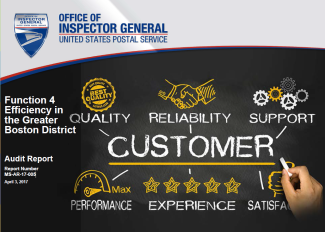Function 4 Efficiency in the Greater Boston District
Background
The U.S. Postal Service tracks customer service activities, known as Function 4, at post offices, stations, and branches as part of its ongoing effort to provide cost-effective, high-quality customer service.
The Greater Boston District operated over 400 post offices, stations, and branches, and processed more than 3.4 billion pieces of mail in fiscal year (FY) 2016. The district served over 2.5 million Post Office Boxes and business and residential addresses.
Postal Service managers have specific policies and procedures for monitoring customer service operational efficiency, such as:
- The Customer Service Variance Model, which assesses retail customer service productivity at select retail units.
- Post Office Box and Distribution Up-Time reports, which track mail timeliness.
- The integrated operating plan and mail arrival profile, which state when mail will arrive and the types of mail that will be present.
- Scanning performance goals, because properly scanning all barcodes will help provide package visibility, retain customers, and generate information that can be used to improve operations and reduce costs.
Our objective was to assess customer service operational efficiency in the Greater Boston District. This audit is one in a series of Function 4 efficiency audits. We selected this district as it was one of the most inefficient districts for customer service in FY 2016 according to our risk model.
What the OIG Found
The Greater Boston District has opportunities to improve customer service operational efficiency. We visited 15 units and identified deficiencies that could contribute to untimely mail delivery and inefficient customer service. Specifically:
- Units did not meet mail timeliness targets. Six units did not meet the target time for distribution of mail to letter carriers and one unit did not meet the target for having mail ready for collection by Post Office Box customers.
- Mail was not properly scanned. Employees at 10 units did not perform required mail arrival scans and “Notice Left” parcels were falsely scanned as “Delivered” at eight units. We referred these instances to the Office of Investigations as appropriate.
- Mail was not accurately measured. Supervisors at 10 units did not follow prescribed procedures for measuring manual mail or did not measure the mail at all.
These conditions occurred because district and local management did not adequately monitor customer service-related operations. Units had outdated mail arrival profiles and integrated operating plans, mail was arriving improperly prepared from the processing plants, and the staff was not following efficient mail processing procedures.
These deficiencies could contribute to late mail delivery and inefficient customer service operations. According to the Customer Service Variance Model, units we visited used 219,775 more workhours than planned in FY 2016, costing the Postal Service almost $8.8 million.
What the OIG Recommended
We recommended management develop strategies to more effectively monitor customer service operations by:
- Coordinating units’ integrated operating plans and mail arrival profiles;
- Actively monitoring employees and mail arrival quality to manage workload and ensure efficient mail processing;
- Instructing unit employees to follow required scanning procedures and verify these procedures are followed; and
- Instructing supervisors to follow prescribed procedures for measuring mail and verify these procedures are followed.

